Tick Symbol in Word (��; ☑ ): 4 different ways, tickm.
Tickm
To insert tick in a box or tick (or check) mark in word press alt + X after typing the corresponding alt-X code.
Top forex bonus promo
Step 1: place your cursor where you want to insert the symbol,
Tick symbol in word (�� & ☑ ): 4 different ways
Tick symbol (��) also known as a check mark or checkmark is a symbol for “yes”. To denote completion of checklist, tick in box (☑) is preferred over tick. Tick symbol in word appears different with different font.
Steps to insert tick in box or tick symbol in word
Step 1: place your cursor where you want to insert the symbol,
Step 2: use any of the following methods. Method 4 is up to 7 times faster.
Method 1 – alt code
Ms word alt code for tick (or check) mark and tick in box are:
| Tick symbol or check mark (��) | tick in box (☑) |
|---|---|
| 128504 | 128505 |
To insert symbol, type corresponding alt code using numpad (not using numerics key using above letters) while holding alt key.
Method 2 – alt X
Alt X code for tick (or check) mark and for tick in box are
| Tick symbol or check mark (��) | tick in box (☑) |
|---|---|
| 1F5F8 | 1F5F9 |
To insert tick in a box or tick (or check) mark in word press alt + X after typing the corresponding alt-X code.
Method 3 – insert symbols
- Navigating to insert tab > symbols and select more symbols

2. Select symbol tab > wingdings font, and double click on desired symbol i.E. �� or ☑.
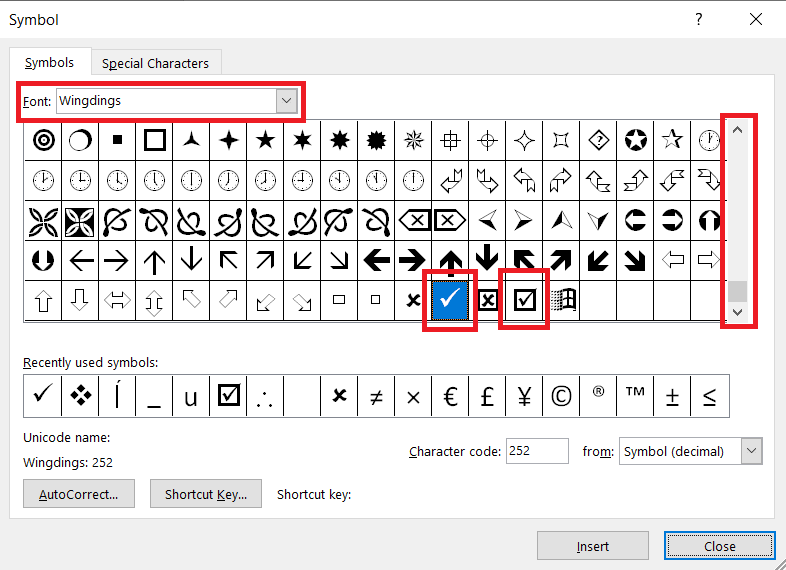
Method 4 – autocorrect (fastest method for tick symbol word)
- Create autocorrect entry
- Locatetick symbol or tick in box symbol (as shown in method 3) by navigating to insert > symbols > more symbols
- Click autocorrect button to open new autocorrect dialogue box
- Type desired shortcut text (e.G. \tickmark) in replace
- Click add
- Close autocorrect and symbol window
2. Type autocorrect entry created in step-1 and press space (for e.G. \tickmark ) to convert into corresponding symbol.
Related posts
Summary
There are four different methods to insert tick symbol in ms word. Of all, alt X and alt code method requires remembering 4-5 digit code. While the insert symbol and autocorrect method are straight forward and relatively easy to remember. Of all these, the smartest way to insert tick symbol or tick in box is autocorrect method as it is fastest and easy to remember.
Tickm
Click on a tick sign below copy and paste tick symbol for check mark that most fits your text.
| Copy paste tick mark symbol | ☑ | ✓ | ✔ | ✅ | √ |
|---|---|---|---|---|---|
| ☒ | ☐ | ✕ | ❎ | �� | |
| ✗ | ✘ | ✖ | ❌ |

Tick symbol meaning

Check mark is used to mark "yes", "approved", "correct", "completed", or "I chose this" inside a checkbox. Sometimes it is used to choose items on a checklist or to check them as done. Though ��-type mark is used usually, x mark is another type of checkmark also sometimes used for this purpose. Most notably on election ballot papers. Dubiously, x mark is also used to indicate a "no", opposite to what the usual ��-type tick mark means. Oddly enough, in finland and sweden tick symbol may mean the opposite - incorrect, wrong. As a verb, to tick (off) or to check (off) means to add such a mark. It is quite common, especially on printed forms, printed documents, and computers (see check box), for there to be squares in which to place ticks.
Check mark and tick symbol on keyboard
Choose your system and find out.
Shift states
Configure your keyboard layout in windows so that you can type all additional symbols you want as easy as any other text. Takes about 5-10 minutes to set things up, but you'll be typing like a boss. You can assign tick mark symbols ☑ and any other text characters to your keyboard using this technique.
Character map
Charmap allows you to view and use all characters and symbols available in all fonts (some examples of fonts are "arial", "times new roman", "webdings") installed on your computer. You can input check box symbols using it.
Check mark emoji on ios (iphone, ipad and ipod touch)

Character palette

Character palette allows you to view and use all characters and symbols, including tick signs, available in all fonts (some examples of fonts are "arial", "times new roman", "webdings") installed on your computer.
Type tick sign on keyboard
There actually are 3 different ways to type symbols on linux with a keyboard. But only third and fourth level chooser keys and unicode hex codes can produce tick text symbols.
Character map
Character map allows you to view and use all characters and symbols available in all fonts (some examples of fonts are "arial", "times new roman", "webdings") installed on your computer. It can also help you lookup unicode codes for entering symbols with keyboard.
Following is a list of HTML and javascript entities for tick symbols. In javascript you should write like a = "this \u2669 symbol" if you want to include a special symbol in a string.
Dogs and ticks
Ticks are spider-like, egg-shaped, blood-sucking creepy crawlies. They have eight legs and vary in size from about 1mm to 1cm long. Adult ticks look a bit like small spiders.
Ticks are common in woodland, grassland and heath areas, but can also be found in your garden if you live in an area with lots of wildlife. You are most likely to come across them in areas with lots of deer or sheep.
You are most likely to come across ticks between spring and autumn, but they are active throughout the year.
Ticks don’t fly or jump, but climb or drop on to your dog’s coat when you brush past the area they are sitting in.
How do I know if my dog has a tick?
Ticks are big enough to spot. Run your hands over your dog’s body when you get back from a walk to check for any lumps or bumps. A tick will feel like a small bump on your pet’s skin.
They tend to attach themselves to areas around a dog’s head, neck, ear and feet. Brushing also helps to remove them.
Ticks vary in size between 1mm and 1cm long, depending on their age. They look like tiny spiders with a whiteish, egg-shaped body. This body becomes larger and darker as it fills with blood.
How do I remove a tick from my dog safely?
Ticks carry diseases, so it’s important to remove any that attach themselves to your dog as soon as possible. Rapid removal lessens the risk of disease.
This can be tricky, as you need to be careful not to squeeze the tick’s body, or allow its head to get stuck inside your dog. Squeezing a tick’s body can cause it to expel blood back into your dog, increasing the risk of infection.
Twisting them off your dog is the best removal method, and pet shops sell handy tick-removal devices to make this easier. Ask your vet for advice.
Why should I protect my dog against ticks?

Ticks are very good at passing on infections from one animal to another. They feed by biting an animal and feasting on blood. This may take several days. Once they have had enough, they drop off.
Ticks transmit microbes that cause diseases, such as lyme disease and babesiosis.
If you live in an area with ticks, it’s a good idea to use a tick treatment that will either repel ticks or kill them if they attach. Spot on treatments, tablets and collars are available and it’s best to consult your vet about which is most suitable for your pet. Read the instructions very carefully as some treatments are for dogs only and can be very dangerous to cats and can even kill them.
What is lyme disease?
Lyme disease is a serious bacterial infection. If your dog has lyme disease, you may notice they become depressed and lose their appetite. Other symptoms include fever, lameness, swollen and painful joints, and swollen lymph nodes.
If you think your pet has lyme disease, contact your vet. They can perform tests and start treatment with antibiotics.
What is babesiosis?
Babesiosis is extremely rare in the UK and the tick that spreads it is so far only found in southern england and on the continent. The first cases of dogs being treated for the disease, caused by the bacterium babesia, were reported in march 2016.
Babesiosis can be spread by tick bites. The incubation period is about two weeks, but some pets are not diagnosed with the disease for months or years after transmission.
If your dog is suffering from babesiosis you may notice they are depressed, have pale gums, a swollen abdomen and a fever. They may also lose their appetite and their skin may become yellowish.
If you notice any of these symptoms after walking your dog in a tick-infested area, contact your vet and make sure to tell them your dog may have been bitten by a tick. Sadly a dog has died after contracting the disease in harlow, essex.
Does babesiosis affect cats?
Recent confirmed cases of babesiosis in essex have been caused by the babesia canis strain. This is not thought to affect cats or other animals and is not a risk to humans.
How can I avoid being bitten by a tick?
Dog owners are more likely to be bitten by ticks if they walk their dogs in areas with a high tick population. Hikers and people who exercise in woodland and the countryside are at risk too.
The best way to avoid a tick-borne disease is to avoid being bitten by a tick.
Wear long sleeved tops when out walking and either tuck trousers into socks, or wear long socks.
Check your clothes for ticks and brush them off quickly if you spot any.
You can also use an insect repellent.
How can I remove a tick from my body?
Ticks should be removed from your body as quickly as possible. Be very careful not to squeeze the tick’s body, or allow its head to get stuck inside your body. Squeezing a tick’s body increases the risk of infection.
Twisting them off your dog is the best removal method, and pet shops sell handy tick-removal devices to make this easier.
Do not try to burn the tick off and don’t cover it with lotions, oils or moisturisers in an attempt to smother it.
After you’ve removed the tick, give the bite area a good wash.
If you develop a rash around the tick bite – these often look like red rings around the bite area – or feel unwell, contact your doctor and make sure to tell them you have been bitten by a tick. The earlier you seek treatment from your doctor, the better.
Can I catch a disease from a tick?
People can catch lyme disease from ticks, just as dogs can.
Lyme disease is serious, so if you walk your dog in areas with deer or sheep make sure you take precautions to avoid being bitten (see above).
Symptoms of lyme disease include a circular rash, muscle and joint pain, and fatigue. Left untreated, the disease can develop into conditions such as viral-like meningitis, facial palsy, arthritis and nerve damage.
Lyme disease can be treated with antibiotics if caught early. Remember to tell your doctor you have been bitten by a tick.
Be particularly careful abroad as ticks in europe can transmit a number of serious diseases.
How to insert a tick or a cross symbol in microsoft word and excel
There are several ways to insert a tick symbol into microsoft word - here are some of the various options.

There are several ways to insert a tick symbol (otherwise known as a check mark or checkmark) into microsoft word, the methods we outline below are relevant for microsoft office 365, microsoft word 2016, microsoft word 2013, microsoft word 2011, microsoft word 2010, microsoft word 2007, microsoft word 2008 and microsoft word 2004
Method 1 - copy and paste - ✓ ✔ ☑ ✅ ✕ ✖ ✗ ✘
To copy and paste a tick or cross, highlight one of the ticks or crosses below, then copy and paste it to your destination
Highlight your preferred symbol below:
To copy - once the symbol is highlighted press ctrl + C
To paste select where you want the symbol and press ctrl + V
Method 2 - font shortcuts
The most common method is to use either the "wingdings 2" font or the "webdings" font. This can easily be found from the drop-down menu and you will be able to choose from a few different styles of tick marks. Alternatively, use the following shortcuts after having selected wingdings 2 or webdings as your font of choice.

Method 3 - symbol command
You can also use the symbol command. Note that you will need to have excel installed to do this. After accessing the "insert" menu, find the "symbol" tab. From this section, choose the "font" option and select "wingdings". The tick mark will be found at the bottom of the list.
This can also be accessed from the "start" menu under the "character map" section (within system tools). Choose the font option and once again, select wingdings. When you hover the mouse over the correct symbol, it will appear larger and you will have the ability to select different versions of the check mark. Finally, copy and paste the icon to the relevant location within the text.
Method 4 - tick symbol character code
Another quick way is to use the character code of the tick symbol. Remember that you will need the numerical keypad as rather than the keyboard. There are a series of codes that will enable you to insert four different tick marks.
1. Change font to "wingdings"
2. Using the numerical keypad (not the horizontal line of numbers), hold down alt and enter any one of the following combination of numbers:
- ALT + 0252
- ALT + 0254
- ALT + 0251
- ALT + 0253
Remember, you will have to change the font to wingdings before the character code is entered. Thereafter, you can switch the font back to the desired appearance.
These are the most efficient ways to insert a tick mark into a standard word document. Note that these methods will vary depending upon the version of microsoft word that you have installed.
Tickm
Emoji meaning A thick check mark / tick displayed on some platforms in a handwritten style. Generally displayed in black, except on…
✅ check mark button
Emoji meaning A check mark that displays with a white outlined appearance. Shows on most platforms with a bright green rounded rectangle…
⭕ hollow red circle
Emoji meaning used as an alternative to a check (tick) in japan for a something that is correct. The opposite of an X (cross mark) for…
Categories
Most popular
Latest news
Events
- ���� australia day
- ���� bastille day
- �� birthday
- ��️ black friday
- ✊�� black lives matter
- ���� canada day
- ���� carnaval
- �� chinese new year
- �� christmas
- ���� cinco de mayo
- �� coronavirus
- �� diwali
- ���� dragon boat festival
- �� earth day
- �� easter
- �� emoji movie
- �� fall / autumn
- �� father’s day
- �� festivus
- �� four twenty / 420
- �� graduation
- �� guy fawkes
- �� halloween
- �� hanukkah
- �� hearts
- ��️ holi
- ���� independence day
- �� mother’s day
- �� new year’s eve
- �� olympics
- ��️�� pride
- �� queen’s birthday
- ☪️ ramadan
- �� spring
- ☘️ st patrick’s day
- ☀️ summer
- �� super bowl
- �� thanksgiving
- �� valentine’s day
- ��️ veterans day
- �� wedding / marriage
- ⛄ winter
- �� winter olympics
- �� working from home
- ⚽ world cup
- �� world emoji day
All emoji names are official character and/or CLDR names and code points listed as part of the unicode standard. Additional descriptions are copyright © emojipedia. Emoji images displayed on emojipedia are copyright © their respective creators, unless otherwise noted.
Emojipedia® is a registered trademark of emojipedia pty ltd; apple® is a registered trademark of apple inc; microsoft® and windows® are registered trademarks of microsoft corporation; google® and android™ are registered trademarks or trademarks of google inc in the united states and/or other countries.
About ticks


About ticks
Conference
Quick links
About ticks
Essentials
- Ticks carrying disease are found across the UK in both town and countryside
- Not all ticks are infected – infection rate in any place in the UK varies from zero to about 20% (8)
- Infection rates in europe are higher
- Ticks can be very small and can go unnoticed
- Most active march to october, but they can be active on mild winter days
- You will not feel the tick attach to you, so check your skin and that of children
- Remove a tick properly, without squashing it
What are ticks?
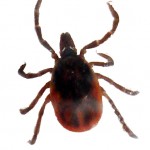
Adult sheep tick – much enlarged
Ticks are related to spiders, mites and scorpions. There are many different species of tick living in britain, each preferring to feed on the blood of different animal hosts. The one most likely to bite humans in britain is the sheep tick, or castor bean tick, ixodes ricinus. Despite its name, the sheep tick will feed from a wide variety of mammals and birds.
Bites from other ticks are possible. Public health england’s tick surveillance scheme (6) has reported the following ticks collected from humans:
These are amongst the 20 tick species recorded as endemic to the UK. Most of them are specialist parasites of wildlife, but do occasionally find their way onto pets and humans.
There are different ticks in other parts of the world and they carry different diseases. If you take your dog abroad, be aware of this and take suitable precautions. The brown dog tick rhipicephalus sanguineus has been brought into the UK from europe on dogs and can survive and reproduce inside a home, unlike the native UK ticks.
In the USA the highest risk comes from the deer tick, ixodes scapularis, but this is not known in europe.
There are four stages to a tick’s life-cycle: egg, larva, nymph, and adult. Larvae, nymphs and adults spend most of the time on the ground protected by leaf litter, leaving this protection to find a meal. They feed only once in each stage, staying attached for a few days, then dropping to the ground to moult into the next stage or overwinter. The whole life cycle from egg to adult lasts around 2 years.
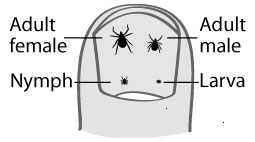
To the naked eye the larvae look like minute pale spiders, not much bigger than a full stop. Nymphs are slightly larger and darker, pinhead or poppy seed size. Larvae have six legs and nymphs and adults eight. It is the nymph which is most likely to bite you.
To see what an adult tick looks like in motion, watch this brief video. Public health england have produced a longer 3 minute video with some very good images of ticks.
Where can they be found?
They can be found in any place with moist air where they are protected from drying out – “I. Ricinus is sensitive to climatic conditions, requiring a relative humidity of at least 80% to survive during its off-host periods, and is therefore restricted to areas of moderate to high rainfall with vegetation that retains a high humidity (i.E. Litter layer and soil remain humid during the day). Typical habitats vary across europe, but typically include deciduous and coniferous woodland, heathland, moorland, rough pasture, forests and urban parks.”[1]
Ticks can also sometimes be found in private gardens, especially those with shady shrubberies or deep vegetation and a strong local wildlife population.
Numbers vary from place to place and from year to year, but ticks can be found across the UK [2]. Not all ticks carry disease, and infection rates in any one place may fluctuate from year to year.[3]
How do they pass on disease?
Ticks feed on the blood of other animals. If a larval tick picks up an infection from a small animal such as a mice, when it next feeds as a nymph it can pass the infection to the next animal or human it bites.
They cannot jump or fly, but when ready for a meal will climb a nearby piece of vegetation and wait for a passing animal or human to catch their hooked front legs. This behaviour is known as questing. The tick will not necessarily bite immediately, but will often spend some time finding a suitable site on the skin, so it is important to brush off pets and clothing before going inside.
Once a tick has started to feed, its body will become filled with blood. Adult females can swell to many times their original size. As their blood sacs fill they generally become lighter in colour and can reach the size of a small pea, generally grey in colour. Larvae, nymphs and adult males do not swell as much as they feed, so the size of the tick is not a reliable guide to the risk of infection. If undisturbed, a tick will feed for around 5 to 7 days before letting go and dropping off.
The bite is usually painless and most people will only know they have been bitten if they happen to see a feeding tick attached to them.
The risk of bacterial infections increases the longer the tick is attached, but can happen at any time during feeding. Viruses can be passed immediately. As tick bites are often unnoticed, it may be difficult to determine how long it has been attached. Any tick bite should be considered as posing a risk of infection although the risk in the UK is low.
Antibiotic treatment “in case” of disease (known as prophylaxis) is not recommended: see our self help page. The small red mark left by the tick will fade over a few days, but see your GP if any symptoms of illness develop over the next couple of weeks.
Adults are most often bitten around the legs. Small children are generally bitten above the waist—check their hairline and scalp.(4)
The public health england website has some useful pages on ticks including a video and details of their tick recording scheme.
What diseases do ticks carry?
There are several diseases that can be caught from a tick bite in the UK – see our separate page on other tick-borne diseases.
Globally, the list of diseases carried by ticks is much longer.
Some ticks carry more than one disease at the same time and could transfer them to you in a single bite. The resulting symptoms can be confusing and liable to misdiagnosis. Treatment in such cases may be difficult. It is not known how often this happens in the UK.
How big are they?
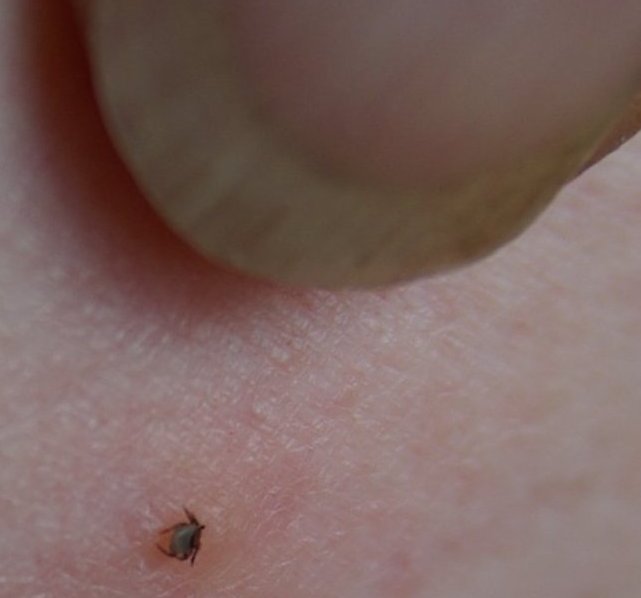
The tick that generally bites humans (the nymph stage) can be as small as a poppy seed as seen here beside the fingernail.
References
1. Medlock et al. “driving forces for changes in geographical
distribution of ixodes ricinus ticks in europe”. Parasites & vectors 2013, 6:1
3. Bettridge et al. “distribution of borrelia burgdorferi sensu lato in ixodes ricinus populations across central britain”. Vector borne and zoonotic diseases. 2013 feb 19;13(X)
4. Robertson JN, gray J, stewart P. “tick bite and lyme borreliosis risk at a recreational site in england.” eur J epidemiol. 2000;16(7):647–52.
5. Medlock JM, et al. Distribution of the tick dermacentor reticulatus in the united kingdom. Med vet entomol. 2017;(april).
Latest news
Be aware!
The tick that generally bites humans can be as small as a poppy seed or full stop on this page. Small children are generally bitten above the waist—check their hairline and scalp. Do NOT use eyebrow tweezers to remove a tick as this may squash it. Use a proper tick removal tool.
Lyme disease action, registered in england & wales, registered charity number 1100448, registered company number 4839410
Home | terms and conditions | site map | last update 2020/08/15 | last review 2019/04/15 | next review 2021/04/15
Lyme disease
Lyme disease is a bacterial infection that can be spread to humans by infected ticks. It's usually easier to treat if it's diagnosed early.
Symptoms of lyme disease
Many people with early symptoms of lyme disease develop a circular red skin rash around a tick bite.
The rash can appear up to 3 months after being bitten by a tick and usually lasts for several weeks.
Most rashes appear within the first 4 weeks.

CDC/SCIENCE PHOTO LIBRARY
LARRY MULVEHILL/SCIENCE PHOTO LIBRARY
Not everyone with lyme disease gets the rash. Some people also have flu-like symptoms in the early stages, such as:
- A high temperature, or feeling hot and shivery
- Headaches
- Muscle and joint pain
- Tiredness and loss of energy
other symptoms of lyme disease
Some people with lyme disease develop more severe symptoms months or years later.
This is more likely if treatment is delayed.
These more severe symptoms may include:
- Pain and swelling in joints
- Nerve problems – such as pain or numbness
- Heart problems
- Trouble with memory or concentration
Most tick bites are harmless
Only a small number of ticks are infected with the bacteria that cause lyme disease.
A tick bite can only cause lyme disease in humans if the tick has already bitten an infected animal.
But it's still important to be aware of ticks and to safely remove them as soon as possible, just in case.
Ticks that may cause lyme disease are found all over the UK, but high-risk areas include grassy and wooded areas in southern england and the scottish highlands.

SINCLAIR STAMMERS/SCIENCE PHOTO LIBRARY
Ticks are tiny spider-like creatures that live in woods and areas with long grass. They're found all over the UK.
Ticks do not jump or fly. They attach to the skin of animals or humans that brush past them.
Once a tick bites into the skin, it feeds on blood for a few days before dropping off.
How to spot and remove ticks
Important
Tick bites are not always painful. You may not notice a tick unless you see it on your skin.
Regularly check your skin and your children's or pets' skin after being outdoors.
To remove a tick safely:
- Use fine-tipped tweezers or a tick-removal tool. You can buy these from some pharmacies, vets and pet shops.
- Grasp the tick as close to the skin as possible.
- Slowly pull upwards, taking care not to squeeze or crush the tick. Dispose of it when you have removed it.
- Clean the bite with antiseptic or soap and water.
The risk of getting ill is low. You do not need to do anything else unless you become unwell.
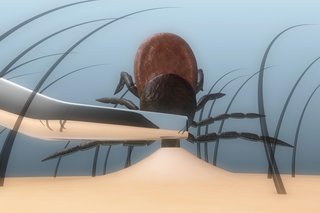
Shotshop gmbh / alamy stock photo
Image no longer available for purchase but license expires: 09th may 2028
Non-urgent advice: see a GP if:
- You have been bitten by a tick or visited an area in the past month where infected ticks are found
- Flu-like symptoms – such as feeling hot and shivery, headaches, aching muscles or feeling sick, or
- A circular red rash
Tell them if you have been in forests or grassy areas.
Coronavirus update: how to contact a GP
It's still important to get help from a GP if you need it. To contact your GP surgery:
- Visit their website
- Use the NHS app
- Call them
What happens at your appointment
Your GP will ask about your symptoms and consider any rash or recent tick bites you know about.
Lyme disease can be difficult to diagnose. It has similar symptoms to other conditions and there's not always an obvious rash.
Two types of blood test are available to help confirm or rule out lyme disease. But these tests are not always accurate in the early stages of the disease.
You may need to be retested if you still have lyme disease symptoms after a negative result.
Treatment from a GP
If your GP thinks you might have lyme disease, they'll prescribe a course of antibiotics.
The antibiotics you’re given will depend on your symptoms, but you may need to take them for up to 28 days. It's important to finish the course, even if you start to feel better.
Some people with severe symptoms will be referred to a specialist in hospital for injections of antibiotics.
Most people with lyme disease get better after antibiotic treatment. This can take months for some people, but the symptoms should improve over time.
People with symptoms of lyme disease that last a long time after treatment may be referred to a specialist in hospital for advice and more blood tests.
Important
Some websites offer tests and treatment for lyme disease that may not be supported by scientific evidence.
Speak to your doctor for advice before buying tests or treatment online.
How to avoid tick bites
To reduce the risk of being bitten:
- Cover your skin while walking outdoors and tuck your trousers into your socks
- Use insect repellent on your clothes and skin – products containing DEET are best
- Stick to paths whenever possible
- Wear light-coloured clothing so ticks are easier to spot and brush off
Ongoing symptoms
A few people who are diagnosed and treated for lyme disease continue to have symptoms, like tiredness, aches and loss of energy, that can last for years.
These symptoms are often compared to fibromyalgia and chronic fatigue syndrome.
It's not clear why this happens to some people and not others. This means there's also no agreed treatment.
Speak to your doctor if your symptoms come back after treatment with antibiotics or they do not start to improve.
Your doctor may be able to offer you further support if needed, such as:
- Referral for a care needs assessment
- Telling your employer, school or higher education institution that you require a gradual return to activities
- Communicating with children and families' social care
Page last reviewed: 27 april 2018
next review due: 27 april 2021
Tickm
Want to thank TFD for its existence? Tell a friend about us, add a link to this page, or visit the webmaster's page for free fun content.
- ▲
- Thump down
- Thump on
- Thump on (someone or something)
- Thump out
- Thumper
- Thumping
- Thunder
- Thunder across
- Thunder out
- Thunder past
- Thunder-boomer
- Thunderbox
- Thunder-thighs
- Thursday
- Thus
- Thus and so
- Thus and such
- Thus and thus
- Thus far
- Thx
- Thy
- Thyself
- Ti
- TIA
- Tic
- Tick
- Tick (something) off on (one's) fingers
- Tick all the (right) boxes
- Tick away
- Tick by
- Tick down
- Tick off
- Tick over
- Tick past
- Tick someone off
- Tick something off on your fingers
- Ticked
- Ticked (off)
- Ticked off
- Ticker
- Ticket
- Ticket (one) for (doing) (something)
- Ticket for some place
- Tickety-boo
- Tickin
- Ticking
- Tickle
- Tickle (one) pink
- Tickle (one) to death
- Tickle (one) to pieces
- Tickle (one's) fancy
- ▼
- ▲
- Tiches
- Tichiodromidae
- TICHK
- Tichodroma
- Tichodroma
- Tichodroma
- Tichodroma muraria
- Tichodroma muriaria
- Tichodroma muriaria
- Tichodromadidae
- Tichodrome
- Tichodrome
- Tichodromidae
- Tichon khrennikov
- Tichorrhine
- TICHR
- Tichy
- TICI
- TICIC
- Ticinesi
- Ticinesi
- Ticinesi
- Ticino
- Ticino
- Ticino
- Ticino
- Ticinum
- Ticinum
- TICIT
- TICJ
- Tick
- Tick (checkmark)
- Tick (disambiguation)
- Tick (disambiguation)
- Tick (one) off
- Tick (something) off on (one's) fingers
- Tick all the (right) boxes
- Tick all the boxes
- Tick all the right boxes
- Tick and tickborne disease
- Tick away
- Tick away
- Tick away
- Tick away
- Tick away
- Tick away
- Tick bean
- Tick beans
- Tick bite
- Tick bite
- Tick bite
- Tick bites
- Tick bites
- Tick bites
- Tick bites
- Tick bites
- Tick borne relapsing fever
- Tick borne rickettsial disease
- Tick box
- Tick box exercise
- Tick by
- ▼
All content on this website, including dictionary, thesaurus, literature, geography, and other reference data is for informational purposes only. This information should not be considered complete, up to date, and is not intended to be used in place of a visit, consultation, or advice of a legal, medical, or any other professional.
Tick removal


About ticks
Conference
Quick links
Tick removal
How do I remove a tick?

DO use a proprietary tick removal tool* (available from this website or many vets and pet shops), and follow the instructions provided. Two common types of removal tool available are illustrated on this page; the hook and the loop are designed to be twisted to facilitate removal.
These tools will grip the head of the tick without squashing the body.


Illustrations are for general guidance and do not represent any particular species.
If no tools are available, rather than delay use a fine thread, something like cotton or dental floss. Tie a single loop of thread around the tick’s mouthparts, as close to the skin as possible, then pull upwards and outwards without twisting.
DO start by cleansing the tweezers/tool with antiseptic. After tick removal, cleanse the bite site and the tool with antiseptic or soap and water.
DO wash hands thoroughly afterwards.
DO save the tick in a container in case a doctor asks for evidence that you have been bitten (label it with date and location). Public health england is also currently running a scheme to investigate ticks – see below.
DO NOT squeeze the body of the tick, as this may cause the head and body to separate, leaving the head embedded in your skin.
DO NOT use your fingernails to remove a tick. Infection may enter via any breaks in your skin, e.G. Close to the fingernail.
DO NOT crush the tick’s body, as this may cause it to regurgitate its infected stomach contents into the bite wound. See this graphic animation of what can happen, courtesy of the lyme borreliosis foundation, hungary.
DO NOT try to burn the tick off, apply petroleum jelly, nail polish or any other chemical. Any of these methods can cause discomfort to the tick, resulting in regurgitation, or saliva release.
Note that the video shows the tool being twisted according to the manufacturer’s instructions. If fine tweezers are used, the tick should be pulled steadily upwards without twisting.
Disposing of the tick
After you have removed your tick, keep it in a sealed container and send it to public health england’s tick surveillance scheme. They will identify it for you and add the information to their database.
Alternatively, kill the tick by crushing it and flushing it down the toilet, or by folding it in a strip of sticky tape and placing it in the waste. Be aware that engorged ticks will contain potentially infected blood, which may splatter when crushed. Do not crush the tick with your fingers and do not allow the crushed tick or the blood it carried to contact your skin.
Now what?!
Don’t worry! The risk from a UK tick bite is very small and you don’t need treatment unless you develop symptoms of illness. The red mark left by the tick bite will fade over a couple of days, so perhaps just make a note on a calendar or diary so if necessary you can tell your doctor when the tick bite was and where it was on your body. Lyme disease symptoms appear on average about 2 weeks after the tick bite.
If you have left a small part of the tick mouthparts in your skin, which can sometimes happen, medical advice is just to leave it and your body will deal with it. You can do more damage digging around with a needle to try to get it out, and this can be particularly distressing for children.
Latest news
Be aware!
The tick that generally bites humans can be as small as a poppy seed or full stop on this page. Small children are generally bitten above the waist—check their hairline and scalp. Do NOT use eyebrow tweezers to remove a tick as this may squash it. Use a proper tick removal tool.
Lyme disease action, registered in england & wales, registered charity number 1100448, registered company number 4839410
Home | terms and conditions | site map | last update 2020/08/05 | last review 2019/07/04 | next review 2022/07/04
so, let's see, what we have: of four different ways to insert tick symbol in word, autocorrect method, where pre-defined text gets converted to symbol is fastest in easiest to remember. At tickm
Contents of the article
- Top forex bonus promo
- Tick symbol in word (�� & ☑ ): 4 different ways
- Steps to insert tick in box or tick symbol in word
- Method 1 – alt code
- Method 2 – alt X
- Method 3 – insert symbols
- Method 4 – autocorrect (fastest method for tick symbol word)
- Related posts
- Summary
- Tickm
- Tick symbol meaning
- Check mark and tick symbol on keyboard
- Shift states
- Character map
- Check mark emoji on ios (iphone, ipad and ipod touch)
- Character palette
- Type tick sign on keyboard
- Character map
- Dogs and ticks
- How do I know if my dog has a tick?
- How do I remove a tick from my dog safely?
- Why should I protect my dog against ticks?
- How can I avoid being bitten by a tick?
- How can I remove a tick from my body?
- Can I catch a disease from a tick?
- How to insert a tick or a cross symbol in microsoft word...
- Method 1 - copy and paste - ✓ ✔ ☑ ✅ ✕ ✖ ✗ ✘
- Method 2 - font shortcuts
- Method 3 - symbol command
- Method 4 - tick symbol character code
- Tickm
- ✅ check mark button
- ⭕ hollow red circle
- Categories
- Most popular
- Latest news
- Events
- About ticks
- About ticks
- Essentials
- What are ticks?
- Where can they be found?
- How do they pass on disease?
- What diseases do ticks carry?
- How big are they?
- References
- Latest news
- Be aware!
- Lyme disease
- Symptoms of lyme disease
- Most tick bites are harmless
- How to spot and remove ticks
- Important
- Non-urgent advice: see a GP if:
- Coronavirus update: how to contact a GP
- What happens at your appointment
- Treatment from a GP
- How to avoid tick bites
- Ongoing symptoms
- Tickm
- Tick removal
- Tick removal
Comments
Post a Comment